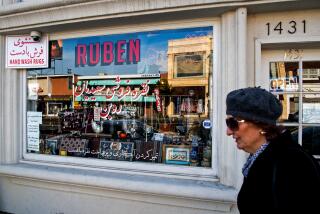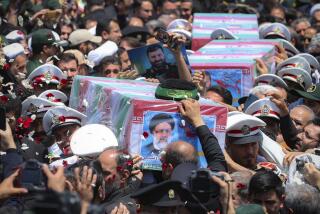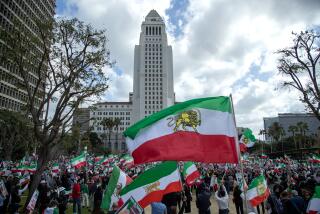Checkmate in Persia : THE SHAH’S LAST RIDE <i> by William Shawcross (Simon & Schuster: $19.95; 380 pp.; 0-671-55231-7) </i>
- Share via
After his fall, Mohammed Reza Pahlavi, the former Shah of Iran, was one of the most tragic figures of the 20th Century--and perhaps the most enigmatic. Henry Kissinger, in his memoirs, lavished praise on the shah, describing him as “among the most impressive leaders that I met.” Yet the shah’s countrymen greeted the news of his death with a laconic radio announcement that “the bloodsucker of the century has died.” A generation of American academics saw the shah’s “White Revolution” as the practical application of their development theories. It was to replace the religious and social values of a traditional society with the industrial and scientific skills of the 20th Century. Within Iran, however, this process was derided as “Westoxication”--a slavish and destructive adoption of all things foreign to the detriment of the nation’s cultural identity.
The shah was praised as an international statesman true to his friends and principles, and, it was argued, he deserved a full measure of loyalty and support from the international community during his time of troubles. Yet, as revolutionary pressures mounted in Iran, it was the shah who abandoned Amir Abbas Hoveyda, his faithful prime minister of many years, arresting him as a scapegoat and leaving him to be murdered by Sadegh Khalkhali, the sadistic Judge Blood of the revolution.
Who and what was this man? Was he a visionary, propelled by a fierce determination to raise his country to the front ranks of world power and influence? Or was he a megalomaniac whose dreams of power eventually led him into an imaginary world where reality was suspended? Was he the brilliant and imperious ruler of his portraits? Or was he the weak and indecisive son of a domineering father? Was he the enlightened product of a Swiss education? Or was he merely an oriental despot in Pierre Cardin suits?
These contradictions wind like the threads of a puzzle through William Shawcross’ moving account of the shah’s odyssey in exile. Shawcross is a contemplative journalist best known for his writings about Cambodia. He has also had a long-standing interest in Iran, and it shows in this balanced and penetrating study. There is a burgeoning academic and popular literature on Iran, inspired by the drama of the 1978-79 revolution. Even the major books on the subject would no longer fit on a five-foot shelf. But in these works, discussion of the role of the shah is typically confined to the period of the revolution and breaks off shortly after his emotional departure from Tehran on Jan. 16, 1979.
For Shawcross, that wintry day is where the story begins. The first half of the book is devoted primarily to retelling the story of the revolution, drawing on interviews and the written accounts of other participants and observers. This smooth and readable series of flashbacks will provide the general reader with an accurate overview of the major events of the revolution and its origins. There are a few surprising tidbits. Israel, he reveals, first established its relationship with Iran as the result of a substantial bribe to Iran’s prime minister in 1950. There is also a detailed account of the plotting by former ambassador Zahedi and a few other individuals in the shah’s entourage to intercept Khomeini’s plane on its way to Tehran and thereby derail the revolution. The shah dismissed the plot out of hand, telling the conspirators, “You must be mad.”
The second half of the book focuses in some detail on events during the shah’s exile, particularly from his arrival in Mexico to his eventual death in Egypt. It is packed with new information and will probably stand as the authoritative account of the shah’s involvement in the politics of the hostage crisis.
It is startling to learn that the shah’s French doctors resorted to euphemisms rather than use the word cancer with their royal patient, thus raising the question of whether the shah was ever aware of the seriousness of his disease while he was on the throne. The medical politics surrounding the shah’s treatment, and the clash of colossal egos among the celebrity doctors, were appalling. As one of the shah’s many doctors said later, “He should have received the best of care. In fact he got near the worst.” Royalty, it seems, can be a liability during a serious illness.
Shawcross interviewed nearly everyone who was in contact with the shah during the last 12 months of his life. By all of these accounts, the shah maintained a remarkable personal dignity and stoicism throughout this period of suffering and humiliation, as teams of doctors and politicians haggled and squabbled over his dying body. Ironically, he may never have been more genuinely regal than during the indignities of his exile and death. This part of the story is told with compassion as well as precise attention to detail. We meet the shah in the words and observations of those who hovered over him--family members, physicians, political figures and a bevy of Rockefeller family retainers.
Curiously, however, the contradictory aspects of this tragic figure are amplified, not resolved, by this close examination. Walter Lippmann once complained that Presidents “do not unbend and tell the story, and say why they did what they did, and what they think about it.” Shawcross has created perhaps the most intimate sketch of the shah yet to appear. But in the end, it is apparent that this intensely private man did not unbend and share his innermost thoughts--neither with his wife nor with his twin sister nor with the many others who passed through his life in its final stages.
The shah occupied center stage during one of the greatest dramas of our times. For his role, he was loved by some and hated by many. This book adds some fascinating new perspectives to our knowledge of the man, but the veil of mystery in which he shrouded himself is still intact, awaiting the verdict of history. That, we may suppose, is exactly what he intended.


